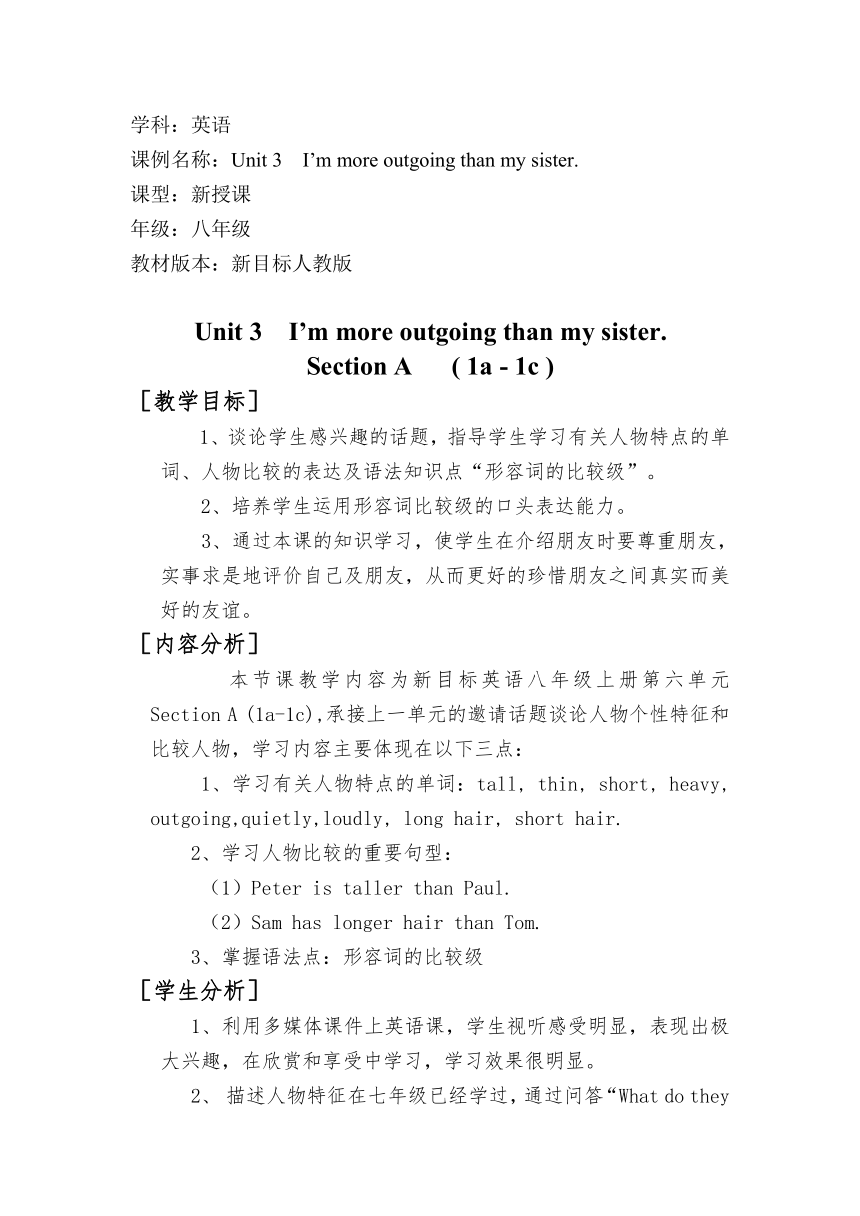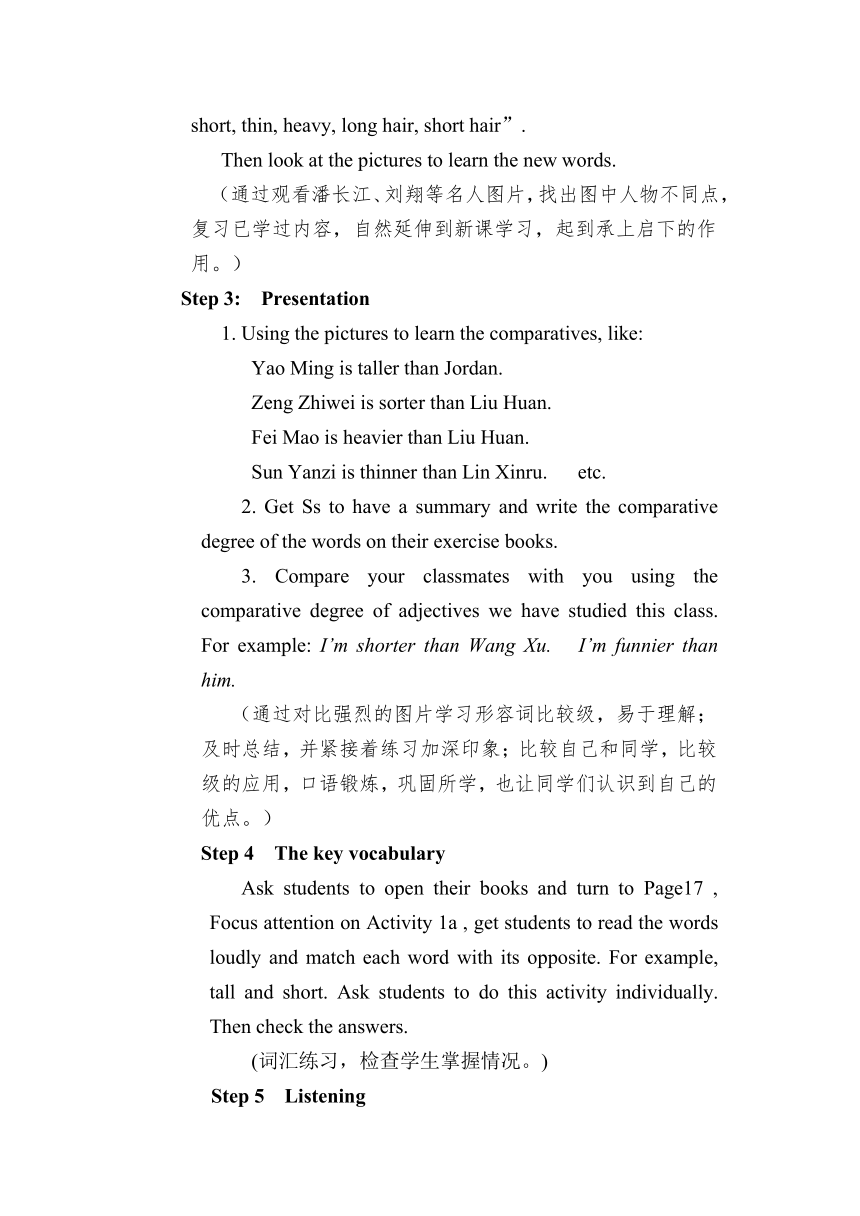Unit 3 I’m more outgoing than my sister. Section A 1a - 1c教案
文档属性
| 名称 | Unit 3 I’m more outgoing than my sister. Section A 1a - 1c教案 |  | |
| 格式 | zip | ||
| 文件大小 | 17.8KB | ||
| 资源类型 | 教案 | ||
| 版本资源 | 人教新目标(Go for it)版 | ||
| 科目 | 英语 | ||
| 更新时间 | 2013-09-24 21:36:03 | ||
图片预览



文档简介
学科:英语
课例名称:Unit 3 I’m more outgoing than my sister.
课型:新授课
年级:八年级
教材版本:新目标人教版
Unit 3 I’m more outgoing than my sister.
Section A ( 1a - 1c )
[教学目标]
1、谈论学生感兴趣的话题,指导学生学习有关人物特点的单
词、人物比较的表达及语法知识点“形容词的比较级”。
2、培养学生运用形容词比较级的口头表达能力。
3、通过本课的知识学习,使学生在介绍朋友时要尊重朋友,实事求是地评价自己及朋友,从而更好的珍惜朋友之间真实而美好的友谊。
[内容分析]
本节课教学内容为新目标英语八年级上册第六单元Section A (1a-1c),承接上一单元的邀请话题谈论人物个性特征和比较人物,学习内容主要体现在以下三点:
1、学习有关人物特点的单词:tall, thin, short, heavy, outgoing,quietly,loudly, long hair, short hair.
2、学习人物比较的重要句型:
(1)Peter is taller than Paul.
(2)Sam has longer hair than Tom.
3、掌握语法点:形容词的比较级
[学生分析]
1、利用多媒体课件上英语课,学生视听感受明显,表现出极大兴趣,在欣赏和享受中学习,学习效果很明显。
2、 描述人物特征在七年级已经学过,通过问答“What do they look like ”,复习旧知,学生能自然而然进入新课学习。
3、学生以前接触过形容词的比较级和最高级,如good-better-best, many-more-most, little-less-least,这为本节课学习奠定了很好的基础,理解起来更为容易。
[课时安排]
Section A (1a-1c) 1课时
[教学方法]
1) Task-based teaching approach
2) The cognitive approach
3) The oral approach
4) The communicative approach
[教学手段]
Chant; multi-media; body language; listening practice;
pattern-drills; question-answer drills.
[教学过程]
Step 1: Warming up
1.Greetings and revision.
Give one of the students a task.(Invite three students to go to the movies with you on Saturday evening.)
2. Chant (Good , better , best)
Good, better, best,
Never let it rest,
Till good is better,
And better is best.
(课前热身,活跃气氛,轻松学习。)
Step 2: Words
Revise the adjectives describing people’s appearance and personalities. Show some photos about famous persons, ask and answer “What do they look like ” to review the words “tall, short, thin, heavy, long hair, short hair”.
Then look at the pictures to learn the new words.
(通过观看潘长江、刘翔等名人图片,找出图中人物不同点,复习已学过内容,自然延伸到新课学习,起到承上启下的作用。)
Step 3: Presentation
1. Using the pictures to learn the comparatives, like:
Yao Ming is taller than Jordan.
Zeng Zhiwei is sorter than Liu Huan.
Fei Mao is heavier than Liu Huan.
Sun Yanzi is thinner than Lin Xinru. etc.
2. Get Ss to have a summary and write the comparative degree of the words on their exercise books.
3. Compare your classmates with you using the comparative degree of adjectives we have studied this class. For example: I’m shorter than Wang Xu. I’m funnier than him.
(通过对比强烈的图片学习形容词比较级,易于理解;及时总结,并紧接着练习加深印象;比较自己和同学,比较级的应用,口语锻炼,巩固所学,也让同学们认识到自己的优点。)
Step 4 The key vocabulary
Ask students to open their books and turn to Page17 , Focus attention on Activity 1a , get students to read the words loudly and match each word with its opposite. For example, tall and short. Ask students to do this activity individually. Then check the answers.
(词汇练习,检查学生掌握情况。)
Step 5 Listening
Show the picture on the screen, and ask “How many people are there in the picture ” ( Nine ). Tell students that maybe they are having a concert and there are three pairs of twins in it. Get several students to read their names to the class. Then say “ Twins are children born at the same time to the same parents. Sometimes they look exactly alike, but not always. The twins in this picture do not look exactly alike.” Now let the students listen to three conversations about the people in the picture. Ask them to listen carefully and number the pairs of twins (1-3) in the picture.
Play the tape for the students and ask them to do this activity. The first time, only listen. The second time, listen and number. The third time, check the answers.
Show the listening materials, and ask students to read them loudly.
(语言实践,听力训练。通过本节的听力训练,让学生了解如何对双胞胎兄弟或姐妹的外貌特征及性格特点进行比较。再给出原文,大声朗读,加深印象。)
Step 6 Pairwork
First ask two students to read the sample conversation to the class. Then point to Pedro and say a new conversation with a student. Students work in pairs. As they talk, move around the room monitoring their work.
Ask a few pairs of students to say one or more of their conversations to the class.
(语言的学习就是为了交际,在这个环节,我把课本图片放大,让学生根据图片内容进行对话,加强学生对人物描述的能力从而培养学生的交际能力,发展他们的思维能力。)
Step 7 Harvest and homework
Give Ss a chance to sum up what have learned in this class.(Ss can talk about it freely.) And then fill in the blanks of “My harvest”. At last the teacher makes a brief sum-up.
Tell them the homework.
Please read the rules of the comparative degree of adjectives on Page 113. And change the words below to the comparative degree.
smart funny
strong early
quiet late
small big
young old
( 让学生来做课堂小结,抓住了学生“敢于开口说英语”的心理,突出主动学习的重要性;教师作综合陈述,犹如给学生一颗定心丸,给学生增添了信心。设置作业,引导自主学习,进一步巩固本课所学内容。)
[板书设计]
Unit 6 I’m more outgoing than my sister.
tall short
thin heavy
long hair short hair
quietly loudly
A + Verb. + adj.-er + than +B
“ A比B更…… ”
[教学反思]
本堂课教学对象是八年级学生,这一阶段的学生思维能力发
展较快,自我意识增强,在情感方面他们能进行自我教育。经过一年的新课程理念的熏陶及实践,学生以有了初步的自主、合作、探究和实践的能力。所以我以英语课程标准为理论,结合八年级学生的心理特点和认知发展规律,运用多媒体辅助教学,通过学生熟悉的图片来讲解单词,并对本堂课的重点句型进行反复操练,加深学生对单词以及形容词比较级的认识,使抽象的语言变得直观,为学生运用英语进行交际创设情景,实现师生互动,生生互动和人机互动的多向交流。
其次,为了实现快乐学习,我首先以说唱(Good, better, best.)导入,再让同学们观看名人图片复习旧知并过渡到新课学习,这都是大家喜闻乐见的形式,从一上课就把课堂气氛调动了起来,同学们兴致高涨地进入学习状态。
再者,听说练习贴近生活,注重语言的实际运用。请同学们比较自己和周围的同学,一下子把生活拉进了课堂,大家也都活跃起来,每个同学都有话可说,都能说上两句,使目标语言得到了很好的运用。
在教学过程中,我收获了不少,但也认识到一点不足。在本节课中语言表达能力强的学生表现的机会相对要多,而另有一些学生却习惯于当听众,很少发表自己的个人意见,这部分学生主要是学习困难生。在以后的教学中要注意引导,上课时可以多给他们机会,多提一些简单的问题给他们,例如本节课在看名人图片复习形容词时,我采取的多是集体回答的形式,这里就可以给那些学困生机会来表现,增强他们学习英语的信心,提高其兴趣。
课例名称:Unit 3 I’m more outgoing than my sister.
课型:新授课
年级:八年级
教材版本:新目标人教版
Unit 3 I’m more outgoing than my sister.
Section A ( 1a - 1c )
[教学目标]
1、谈论学生感兴趣的话题,指导学生学习有关人物特点的单
词、人物比较的表达及语法知识点“形容词的比较级”。
2、培养学生运用形容词比较级的口头表达能力。
3、通过本课的知识学习,使学生在介绍朋友时要尊重朋友,实事求是地评价自己及朋友,从而更好的珍惜朋友之间真实而美好的友谊。
[内容分析]
本节课教学内容为新目标英语八年级上册第六单元Section A (1a-1c),承接上一单元的邀请话题谈论人物个性特征和比较人物,学习内容主要体现在以下三点:
1、学习有关人物特点的单词:tall, thin, short, heavy, outgoing,quietly,loudly, long hair, short hair.
2、学习人物比较的重要句型:
(1)Peter is taller than Paul.
(2)Sam has longer hair than Tom.
3、掌握语法点:形容词的比较级
[学生分析]
1、利用多媒体课件上英语课,学生视听感受明显,表现出极大兴趣,在欣赏和享受中学习,学习效果很明显。
2、 描述人物特征在七年级已经学过,通过问答“What do they look like ”,复习旧知,学生能自然而然进入新课学习。
3、学生以前接触过形容词的比较级和最高级,如good-better-best, many-more-most, little-less-least,这为本节课学习奠定了很好的基础,理解起来更为容易。
[课时安排]
Section A (1a-1c) 1课时
[教学方法]
1) Task-based teaching approach
2) The cognitive approach
3) The oral approach
4) The communicative approach
[教学手段]
Chant; multi-media; body language; listening practice;
pattern-drills; question-answer drills.
[教学过程]
Step 1: Warming up
1.Greetings and revision.
Give one of the students a task.(Invite three students to go to the movies with you on Saturday evening.)
2. Chant (Good , better , best)
Good, better, best,
Never let it rest,
Till good is better,
And better is best.
(课前热身,活跃气氛,轻松学习。)
Step 2: Words
Revise the adjectives describing people’s appearance and personalities. Show some photos about famous persons, ask and answer “What do they look like ” to review the words “tall, short, thin, heavy, long hair, short hair”.
Then look at the pictures to learn the new words.
(通过观看潘长江、刘翔等名人图片,找出图中人物不同点,复习已学过内容,自然延伸到新课学习,起到承上启下的作用。)
Step 3: Presentation
1. Using the pictures to learn the comparatives, like:
Yao Ming is taller than Jordan.
Zeng Zhiwei is sorter than Liu Huan.
Fei Mao is heavier than Liu Huan.
Sun Yanzi is thinner than Lin Xinru. etc.
2. Get Ss to have a summary and write the comparative degree of the words on their exercise books.
3. Compare your classmates with you using the comparative degree of adjectives we have studied this class. For example: I’m shorter than Wang Xu. I’m funnier than him.
(通过对比强烈的图片学习形容词比较级,易于理解;及时总结,并紧接着练习加深印象;比较自己和同学,比较级的应用,口语锻炼,巩固所学,也让同学们认识到自己的优点。)
Step 4 The key vocabulary
Ask students to open their books and turn to Page17 , Focus attention on Activity 1a , get students to read the words loudly and match each word with its opposite. For example, tall and short. Ask students to do this activity individually. Then check the answers.
(词汇练习,检查学生掌握情况。)
Step 5 Listening
Show the picture on the screen, and ask “How many people are there in the picture ” ( Nine ). Tell students that maybe they are having a concert and there are three pairs of twins in it. Get several students to read their names to the class. Then say “ Twins are children born at the same time to the same parents. Sometimes they look exactly alike, but not always. The twins in this picture do not look exactly alike.” Now let the students listen to three conversations about the people in the picture. Ask them to listen carefully and number the pairs of twins (1-3) in the picture.
Play the tape for the students and ask them to do this activity. The first time, only listen. The second time, listen and number. The third time, check the answers.
Show the listening materials, and ask students to read them loudly.
(语言实践,听力训练。通过本节的听力训练,让学生了解如何对双胞胎兄弟或姐妹的外貌特征及性格特点进行比较。再给出原文,大声朗读,加深印象。)
Step 6 Pairwork
First ask two students to read the sample conversation to the class. Then point to Pedro and say a new conversation with a student. Students work in pairs. As they talk, move around the room monitoring their work.
Ask a few pairs of students to say one or more of their conversations to the class.
(语言的学习就是为了交际,在这个环节,我把课本图片放大,让学生根据图片内容进行对话,加强学生对人物描述的能力从而培养学生的交际能力,发展他们的思维能力。)
Step 7 Harvest and homework
Give Ss a chance to sum up what have learned in this class.(Ss can talk about it freely.) And then fill in the blanks of “My harvest”. At last the teacher makes a brief sum-up.
Tell them the homework.
Please read the rules of the comparative degree of adjectives on Page 113. And change the words below to the comparative degree.
smart funny
strong early
quiet late
small big
young old
( 让学生来做课堂小结,抓住了学生“敢于开口说英语”的心理,突出主动学习的重要性;教师作综合陈述,犹如给学生一颗定心丸,给学生增添了信心。设置作业,引导自主学习,进一步巩固本课所学内容。)
[板书设计]
Unit 6 I’m more outgoing than my sister.
tall short
thin heavy
long hair short hair
quietly loudly
A + Verb. + adj.-er + than +B
“ A比B更…… ”
[教学反思]
本堂课教学对象是八年级学生,这一阶段的学生思维能力发
展较快,自我意识增强,在情感方面他们能进行自我教育。经过一年的新课程理念的熏陶及实践,学生以有了初步的自主、合作、探究和实践的能力。所以我以英语课程标准为理论,结合八年级学生的心理特点和认知发展规律,运用多媒体辅助教学,通过学生熟悉的图片来讲解单词,并对本堂课的重点句型进行反复操练,加深学生对单词以及形容词比较级的认识,使抽象的语言变得直观,为学生运用英语进行交际创设情景,实现师生互动,生生互动和人机互动的多向交流。
其次,为了实现快乐学习,我首先以说唱(Good, better, best.)导入,再让同学们观看名人图片复习旧知并过渡到新课学习,这都是大家喜闻乐见的形式,从一上课就把课堂气氛调动了起来,同学们兴致高涨地进入学习状态。
再者,听说练习贴近生活,注重语言的实际运用。请同学们比较自己和周围的同学,一下子把生活拉进了课堂,大家也都活跃起来,每个同学都有话可说,都能说上两句,使目标语言得到了很好的运用。
在教学过程中,我收获了不少,但也认识到一点不足。在本节课中语言表达能力强的学生表现的机会相对要多,而另有一些学生却习惯于当听众,很少发表自己的个人意见,这部分学生主要是学习困难生。在以后的教学中要注意引导,上课时可以多给他们机会,多提一些简单的问题给他们,例如本节课在看名人图片复习形容词时,我采取的多是集体回答的形式,这里就可以给那些学困生机会来表现,增强他们学习英语的信心,提高其兴趣。
同课章节目录
- Unit 1 Where did you go on vacation?
- Section A
- Section B
- Unit 2 How often do you exercise?
- Section A
- Section B
- Unit 3 I'm more outgoing than my sister.
- Section A
- Section B
- Unit 4 What's the best movie theater?
- Section A
- Section B
- Unit 5 Do you want to watch a game show?
- Section A
- Section B
- Unit 6 I'm going to study computer science.
- Section A
- Section B
- Unit 7 Will people have robots?
- Section A
- Section B
- Unit 8 How do you make a banana milk shake?
- Section A
- Section B
- Unit 9 Can you come to my party?
- Section A
- Section B
- Unit 10 If you go to the party, you'll have a grea
- Section A
- Section B
